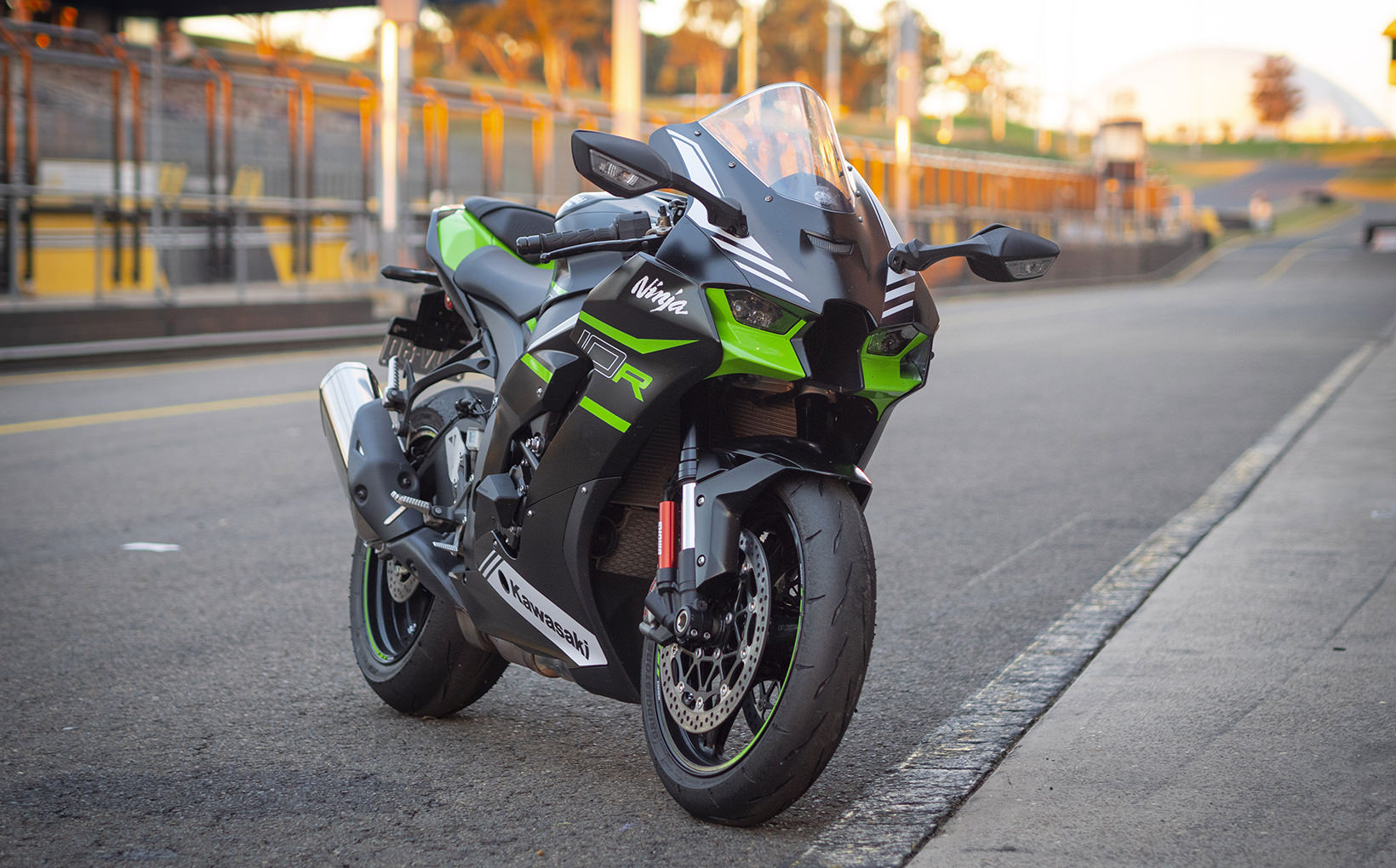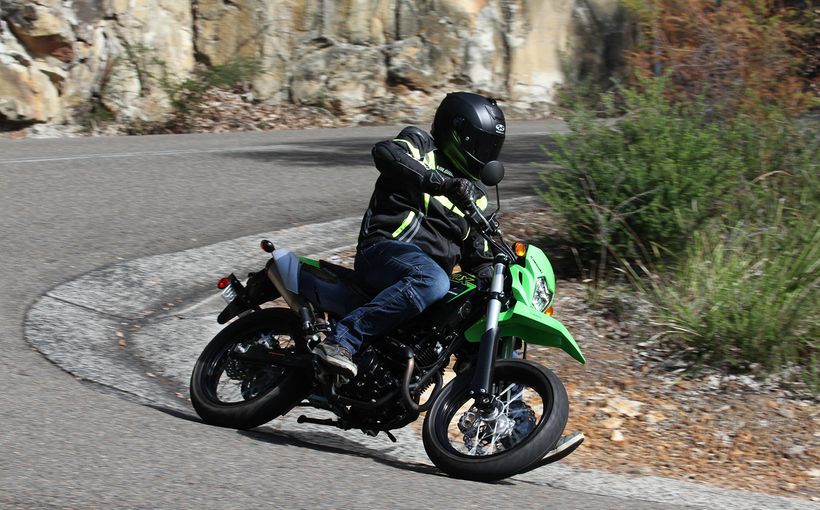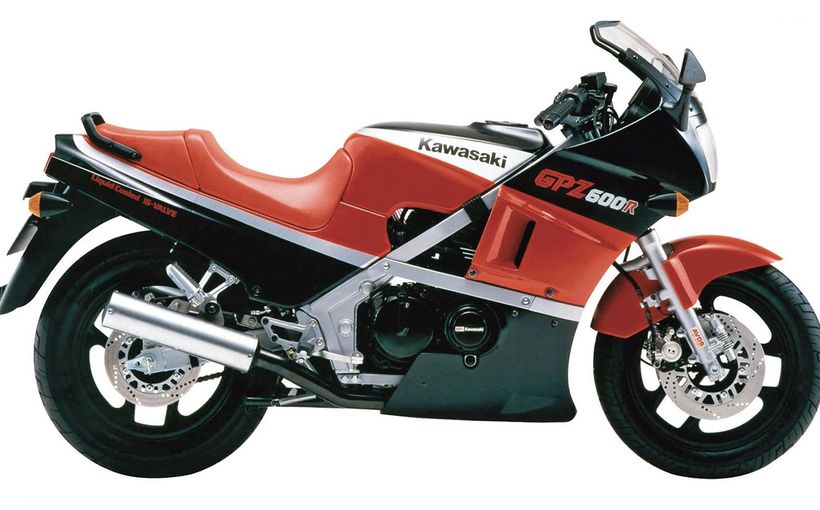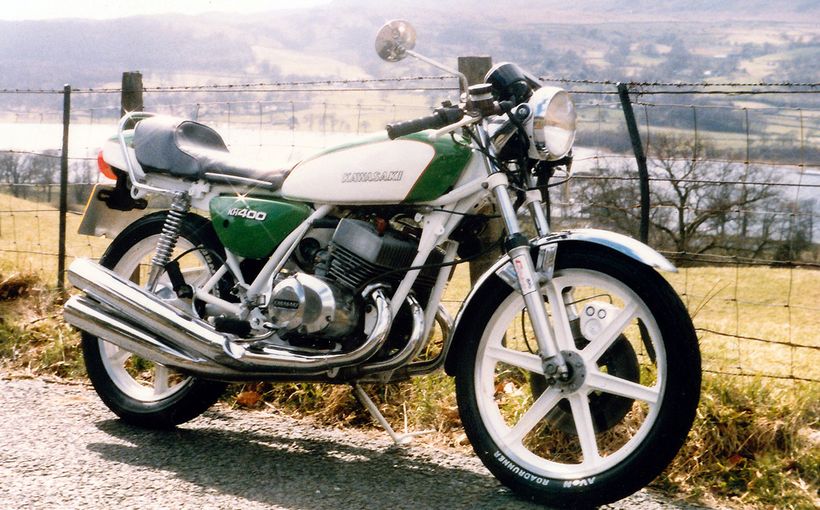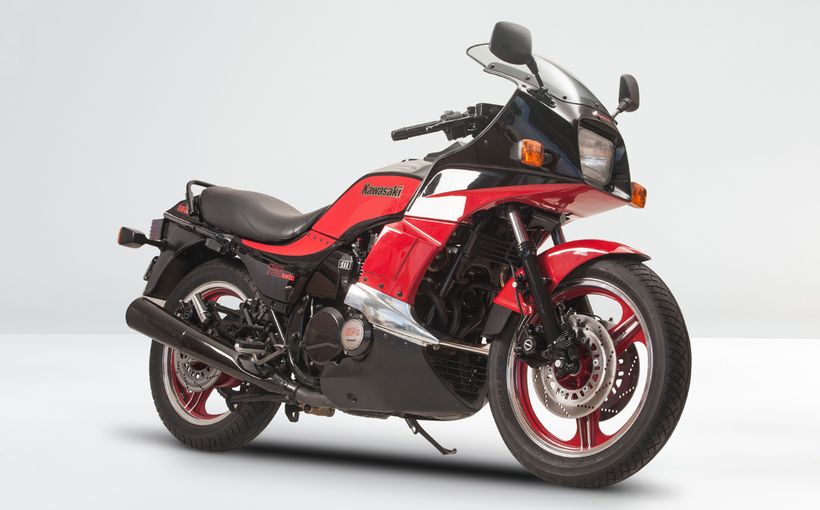2021 Kawasaki Ninja ZX-10R: Green Winner

By Phil James
Cruise control can save your licence on any bike, but on a 200hp sports missile like the new fifth-generation Kawasaki ZX-10R, it could save you from being locked up. The bike’s ability to mask the speed you’re doing — 110km/h is so effortless for this bike you almost feel like you could get off and walk faster — that using the cruise control on highways and freeways makes so much sense.
It’s crazy easy to find yourself 30 or more km/h over the speed you thought you were doing, and the penalties for doing so these days are harsh, so Kawasaki’s inclusion of a cruise control on this machine is a very smart move, and something I think owners will use a lot.
Of course, the ZX-10R’s natural home isn’t highways or freeways, but racetracks, so if the occasional track day is your idea of fun, the sharpest Ninja should be on your wanted list.
For 2021, Kawasaki has given the ZX-10R a carefully considered update. The outgoing Gen 4 model was an impressive machine, delivering the company six World Superbike Championships on the trot. That got under the competitor’s skin and they’ve responded, closing the gap. As good as the Gen 4 still is (Gen 4s still race in WSBK), the bike needed tweaking by Kawasaki to stay ultra-competitive.
For some context, Kawasaki doesn’t contest MotoGP, so WSBK success is hugely important. Therefore, any changes made to the production bike will be meaningful… because results matter.
Unlike a MotoGP bike, a production bike must work in the real world of congestion, low speed limits, bureaucratic compliance and not scare the daylights out of riders with moderate skills. Designing such a bike that can be a WSBK contender is arguably as hard as designing a GP bike.
So, has Kawasaki improved the ZX-10R’s “track” performance without compromising street usability? To drill into this, ARR has departed from normal service and decided to focus on the bike’s track ability. We’ll still offer an opinion on it as a street bike, but track performance is what drives sales. We had racer Keo Watson look at the bike purely from that perspective, and I’ve considered it from a track day/sports bike owner’s perspective.

DESCRIPTION AND DETAILS
The ZX-10 comes in two models, the R and the track-focused RR model (only 500 units worldwide). Differences between the two aren’t great, but important for those who race at a high level.
The RR variant has lighter forged wheels, an engine with lighter internals and braided front brake lines. With its 400rpm higher rev limit, it maximises the potential of Kawasaki’s optional race kit. Important changes to win races, but only the lighter wheel set would be noticeable to 98 per cent of riders. There is a $16,500 price difference between the two, so stepping into an RR model would be a weighty purchase decision for most.
In all other respects, the bikes are practically identical. The headline changes to the Gen 5 include two-degree steeper steering geometry and 10mm-longer wheelbase (improving steering lightness without compromising stability). The fairing has been revised for better aerodynamic performance with integrated winglets and a taller screen. The extra fairing width has allowed wider bars that have also been moved 10mm forward. This, along with higher footpegs, results in a noticeable change to rider positioning aimed at improving track comfort and responsiveness to rider inputs.
2021 brings refinement to what is already a good electronics package. There are now four integrated riding modes — Sport, Road, Rain and Rider. Four settings of the configurable Rider mode can be stored, with combinations of engine power and traction control as required. You could store your settings for four different tracks or different conditions — cold weather, wet track, race etc.
The electronics package also includes (as previously) competition-level traction control (S-KTRC), launch control (KLCM), supersport grade ABS (KIBS), bi-directional quick shifter and engine brake control (KEBC).
The conductor for this electronic choir is the Kawasaki Cornering Management Function (KCMF). It oversees how the bike’s systems are responding to changes in the bike’s chassis orientation (as measured by the Bosch Inertial Management Unit). A CAN coupler is included (under the seat) for fitment of an aftermarket data logger.
Smaller changes are numerous. The exhaust, swingarm mount point, lower triple clamp, suspension settings, steering damper settings, rear brake pads and rider’s seat are all subtly changed for track performance.
Some updates aren’t performance-driven; they’re aimed at making the bike more user-friendly and market relevant — things like the cruise control, phone connectivity, TFT screen and LED indicators.
When connected to a smart phone (via Kawasaki’s Rideology app), settings can be viewed and changed and ride info (including route information) can be seen. Text messages are shown on the dash.

TRACK PERFORMANCE
It’s likely most owners will either aspire to do a track day, or are already hooked and drawn to the ZX-10R as a premium solution to going fast in circles. As recreational track riders ourselves, we at ARR can see the attraction.
Kawasaki presented us with a ZX-10R (with no special track preparation) at Sydney Motorsport Park. It was a case of… this is what the buyer gets, see what you think. Track-specific set-up consisted of selecting Sport mode, folding the mirrors back, dropping the OEM Bridgestone tyres to track pressures and off we went.
After a couple of gentle laps to warm the tyres, the throttle was opened hard and the bike’s character started to reveal itself. In the interests of full disclosure, I should mention I own a registered Gen4 ZX-10R, with a couple of track mods.
For 2021, the engine’s midrange seems a little crisper while the famed sizzling top end remains. The new fairing is better than the old. The Gen 4 needed a taller double bubble screen for high speeds. Over 200km/h the standard screen was hard to get under. That’s now fixed and high-speed stability is excellent.
Like the Gen 4, the Gen 5 impresses with its user-friendliness. It doesn’t intimidate. Throttle response is linear, with good feel for what the rear tyre is doing. The chassis geometry changes are noticeable. It’s not a different bike to the Gen 4, but it is easier to initiate a turn and make corrections if required. With a track-specific set-up and sticky tyres, it would be even better.
To evaluate that potential, we had the privilege of doing a session on the spare BC Performance ASBK ZX-10RR. It was essentially standard with minor mods most would make for a dedicated track bike (or club racer). It was fitted with race glass, full exhaust system and slicks. It had also been tuned (not surprising, as that’s BC Performance’s business). Suspension was standard.
Released from the need to be “streetable”, this Ninja was much sharper in every way. The engine had more punch and the bike responded immediately to rider inputs. My time on this bike was limited but it was apparent that with more of it, I may have been looking at my fastest lap times ever. Yet it still retained its unintimidating, user-friendly character. There was only one fly in the ointment: being an RR model, as ridden, it would be a $50k bike.
Apart from the braided front lines, the brakes on both R and RR are the same and the way they interact with the ZX-10R chassis is just superb. They are progressive, powerful and give wonderful feedback to the rider. Controlled, hard-trail braking is easy. Even journalists feel like seasoned racers.
One issue that was noted was headshake if the rider is too aggressive with the throttle exiting corners (it’s a common issue for 200hp bikes). This was partially a consequence of the softish (for track) OEM suspension setting, resulting in excessive rear squat and front unweighting.


The Öhlins electronic steering damper helps, but once the front wheel starts to lift off while the bike is cranked over, headshake will happen. ASBK bikes are fitted with manual steering dampers, but it’s likely an issue they still have to manage.
From another perspective, the ZX-10R inspires so much confidence and has such good drive on corner exits that the rider will be tempted to go too hard on the throttle and get headshake. When it did happen, it wasn’t scary, just annoying.
One thing we really like is the cassette gearbox. In the unlikely event of an issue, it’s economically fixable as the engine doesn’t have to come out. On most bikes, a gearbox issue can effectively write off a bike.
What’s impressive is that Keo had the bike at the pointy end of the fast group and most of that group were on club race bikes. Yet the ZX-10R had a number plate, horn, blinkers, lights, soft suspension, and half-worn road tyres. By any measure, it is a fast bike…
But there’s more! As touched on earlier, Kawasaki sells a race kit for those who really want to ratchet it up. See the breakout on page 54 for details.

STREET PERFORMANCE
All that track capability does compromise the ZX-10R as a road bike. It’s just overkill. Overkill in the same way as using a howitzer to fire balls for tennis practice… but it doesn’t detract from the fact that being able to screw a number plate onto this monster is pretty special. So, to fairly assess it as a road bike, ARR can only benchmark it in relation to others of its type.
Ideally hyper sportsbikes should be tolerable at urban speeds, they should run smoothly without undue suspension harshness, braking should be progressive, and they should be pain-free for as long as possible.
Looking at the ZX-10R through this lens, and much to ARR’s surprise, the ergonomic changes on the ZX-10R haven’t made it worse. Strangely, it seemed better than my Gen 4. This was well tested by circulating in Sydney traffic for about an hour (I got lost in Western Sydney). The Gen 4 would have disciplined me severely for that error; sportsbikes on public roads don’t mix well, but the new bike wasn’t too bad.
As opposed to the rider, the bike is happy to dawdle around at 60-80km/h. It’s smooth and snatch-free, the brakes don’t bite excessively, all the controls are easy to use, the instrumentation is easy to read, the seat wasn’t cast in a foundry, and the suspension, while firm, isn’t brutal. The new cruise control works well as a license protection aid.

Dynamically it is as expected. More capability than it’s possible to use on the road. Given the state of our roads and our granny speed limits, it’s not even possible to go fast enough to take advantage of the racing crouch. The Z H2 is much more fun as a street sportsbike.
The ZX-10R does have one standout trait relevant to sport riding: a super-planted front end. I don’t think we’ve ridden a bike with a better one.
Gripes? Not many. The clutch isn’t span-adjustable and its action isn’t as light as the best ones. Not a problem on the track as the clutch isn’t used, but it could be improved for stop/go traffic. This isn’t a substantive issue, rather a case of not quite matching the best on offer from competitors.

CONCLUSION
Keo and I both agree the Gen 5 Ninja ZX-10R is an excellent choice for track riding. It fills the needs of racers as well as track day riders. For a racer there’s a very competitive bike in there, not requiring extensive and expensive mods to access serious speed.
For track day people it’s teddy bear friendly, yet with only a little set-up, and good tyres, it’s capable of a blistering lap times. A rider could start learning the track trade with this bike and by making set-up changes as they improve, the bike will carry him/her through to the top level. The old path of starting on a 600 probably isn’t required.
It works as well as any hyper sportsbike on the road, possibly even as a “day to day” bike for those who find the riding position acceptable.

The RR variant is marginally better on the track, but not $16,500 better. We’d suggest the value sweet spot (for anybody not contesting ASBK) is a ZX-10R with the optional Marchesini forged wheels (roughly $3k, which is fair). Of course, track riders with deep pockets should get the RR variant, but the single R is not a poor relation by any means.
The 2021 model is a genuine step forward for track riders and it still retains (and possibly improves) its road performance. Others seem to have reached the same conclusion; at the time of writing, Kawasaki had sold out of bikes. Those who are keen should chat to their local dealer to check availability.
THE VIDEO
Kawasaki asked Australian Road Rider to ride the new ZX-10R at Sydney Motorsport Park, and on the road. We asked a young champion, Keo Watson, to present the video for us and roped in chief road tester Phil James for the print story and to talk about his experiences with his ZX-10R track day bike on the video too.
SPECIFICATIONS: 2021 Kawasaki ZX-10R (ZX1002LMFAN)
ENGINE
Liquid-cooled, 4-stroke, DOHC, 4-valve, 4-cylinder
Capacity: 998cc
Bore x stroke: 76 x 55 mm
Compression ratio: 13.0:1
Fuel System: Fuel Injection. 47mm throttle bodies, dual injection
Ignition: Digital
PERFORMANCE
Claimed maximum power: 149.3KW (203PS) at 13,200 rpm. 156.8 (213PS) with ram air
Claimed maximum torque: 114.9Nm at 11,400 rpm
TRANSMISSION
Type: 6 speed cassette
Final drive: Chain
Clutch: Wet Multiplate, back torque limiting
CHASSIS AND RUNNING GEAR
Chassis: Twin Spar, cast Aluminum
Front suspension: 43mm inverted (BFF) with external comp chamber, compression, rebound and preload adjustment.
Rear suspension: Horizontal back link, BFRC lite gas-charged with compression, rebound and preload adjustment.
Front brakes: Hydraulic dual discs, 330mm, Brembo four-piston Monoblock M50 radial-mount callipers, ABS
Rear brake: Hydraulic single disc, 220mm, single piston calliper, ABS
Tyres: Front: 120/70 ZR 17M/C(58W) Rear: 190/55 ZR 17M/C(75W)
ELECTRONIC RIDER AIDS
Brake Control (ABS): Lean angle sensitive (KIBS)
Traction Control: Yes. 5 levels plus “off” (S-KTRC)
Launch Control: Yes. (KLCM)
Engine Brake Control: Yes.
Power Modes; Yes. 3 modes, low, mid and full power.
Quick Shifter: Yes. Bi-directional
Riding Modes: Yes. 3 default modes, 4 configurable modes.
Chassis Control Software: Yes. Kawasaki Cornering Management Function (KCMF)
DIMENSIONS AND CAPACITIES
Rake: 25deg
Trail: 105deg
Claimed wet weight: 207Kg
Ground Clearance: 135mm
Seat height: 835 mm
Wheelbase: 1450 mm
Fuel capacity: 17L
ETCETERA
Price: $27,967 (ride away)
Colours: Lime Green with Ebony Pearl & Blizzard White (Kawasaki Racing Team) - GN1; Flat ebony (Kawasaki Racing Team) – BK2
Test bike supplied by: Kawasaki Australia
Warranty: 2 years, unlimited kilometres.

